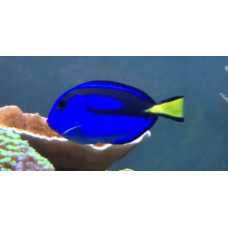Latin name
Paracanthurus hepatus
Other name
Palette surgeonfish, royal blue tang, hippo tang, blue hippo tang, flagtail surgeonfish, Pacific regal blue tang, blue surgeonfish.
Identification
The body is laterally compressed, ovoid in shape. This species is characterized by long dorsal and anal fins and a steeply sloping forehead. Large eyes provide excellent orientation in dark water.
Features of fish fins
Dorsal spines (total): 9; Dorsal soft rays (total): 19-20; Anal spines: 3; Anal soft rays: 18-19.
Fish colouring
Body coloration is dark blue with a prominent black pattern, tail fin is yellow.
Distribution
Widespread in the Indo-Pacific region from East Africa to Japan and Samoa.
Habitat
Tropical marine benthopelagic species. Prefers to live on the outer slopes of coral reefs at depths down to 40 m between corals and in rock crevices.
Size
Body length ranges from 15 to 30 cm. Males are slightly larger than females. Life expectancy is 20 years.
Behavior
Juveniles live in schools, adults in pairs or individually.
Food and feeding habits
They feed on plankton as well as algae, which distinguishes them from most tangs.
Reproduction
Puberty occurs at two years of age. Juveniles live in small schools, hiding from predators among the coral.
Fishing
Fished for sale to aquariums.
Relationship with a person
Royal Tang is the heroine of the animated movie Finding Nemo, Dory's forgetful fish.
Poisonous species.
| Classification | |
| Phylum | Chordata |
| Class | Actinopterygii |
| Squad | Acanthuriformes |
| Family | Acanthuridae |
| Genus | Paracanthurus |
| Species | P. hepatus |
| Features | |
| Conservation status | Least Concern |
| Habitat | Pelagic |
| Life span, years | 20 |
| Maximum body weight, kg | No information |
| Maximum length, cm | 30 |
| Sailing speed, m/s | No information |
| Threat to people | Not edible |
| Way of eating | Planktonophage |
Regal tang
Tags: regal tang



